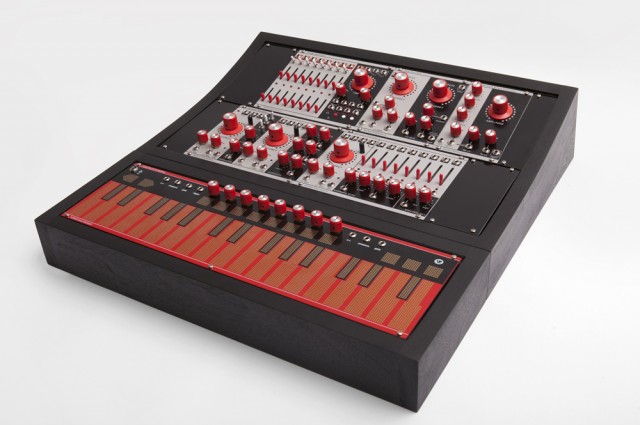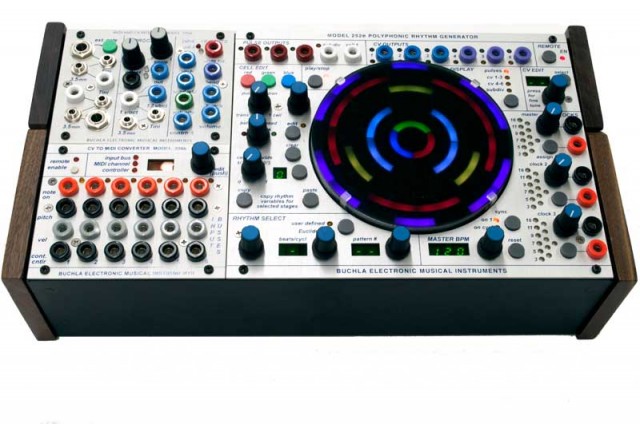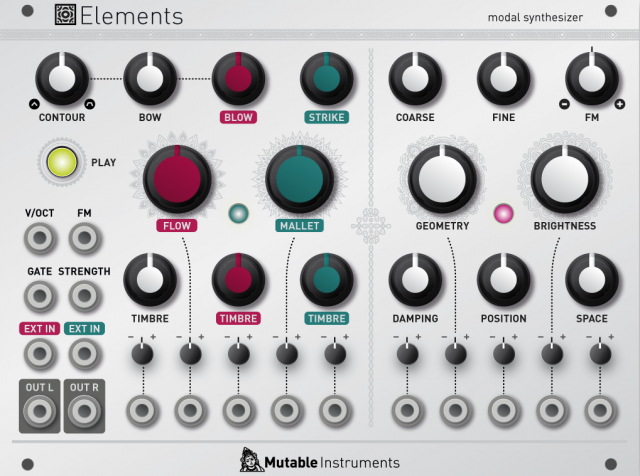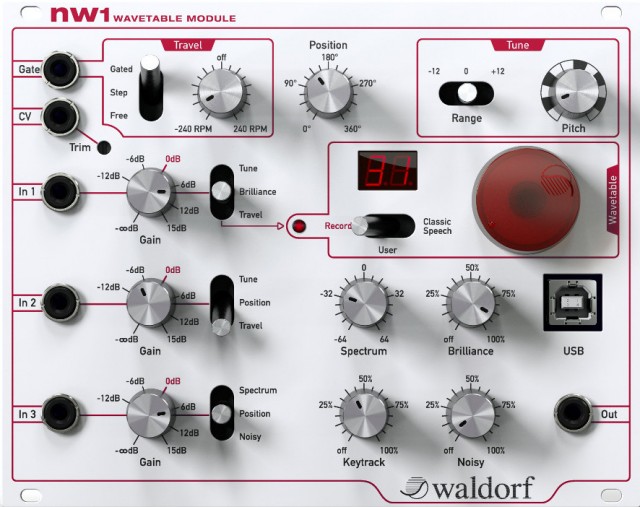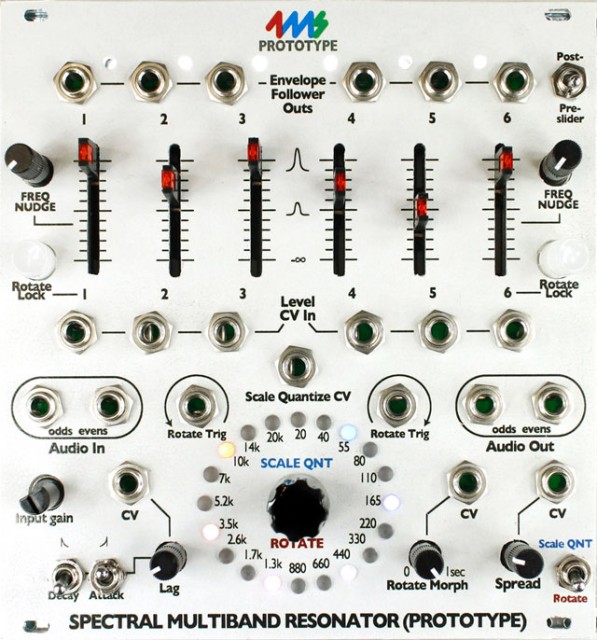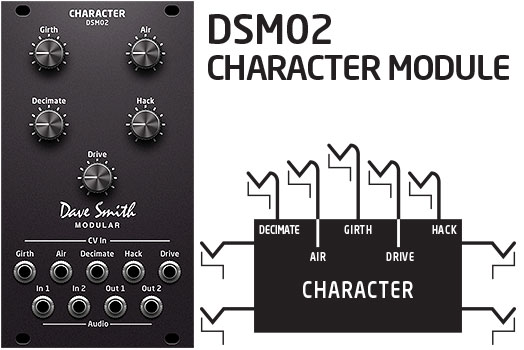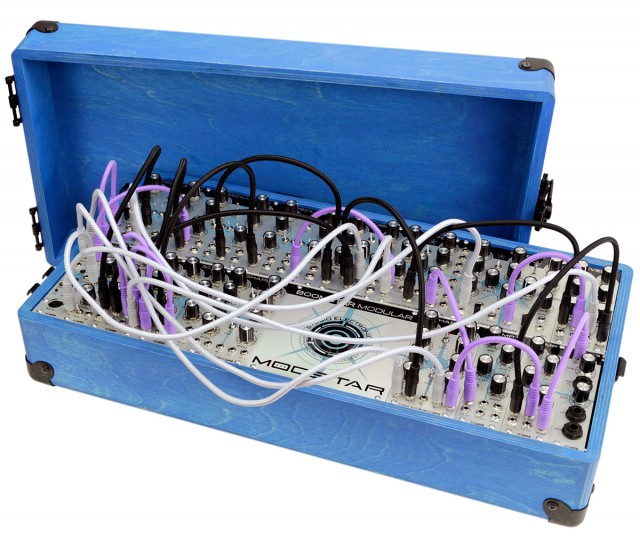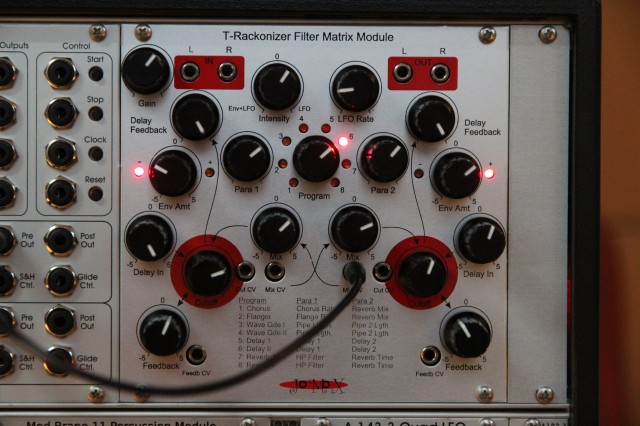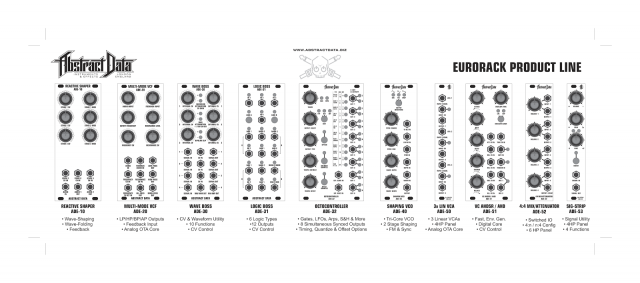You know you’re at peak modular when Moog is reissuing 1970s synths for US$30,000.
It wasn’t long ago that people were relegating modular synths to closets, selling them off, and even – really – throwing them in dumpsters. Now, the once-archaic racks of synthesizers connected with patch cords are suddenly cool. Moog rockstar chic aside, the trend is mainly driven by Eurorack, a format introduced years ago by Doepfer that has made it easier to manufacture and buy interchangeable rigs.
Moog is making only a handful of those System 55 rigs, so even they acknowledge you probably can’t afford them. Let’s focus instead on the stuff that musicians might actually buy. And there’s a lot — too much to handle, even. So rather than clog CDM with a zillion stories on each new module that came out, I’ve been quietly keeping notes and talking to those in the know to give you a rough field guide to the best new modular gear. (I’m sure I’ve missed some, because there’s just so much, but this should give an approximation.)
Most of this equipment debuted at California’s NAMM – expect still more to pop up between now and Musikmesse, the German (and European) answer to the US trade show.
Is all of it equally useful? Absolutely not. There’s an enormous fetish factor to modular, and it’s clear that the market is partly driven by a core of enthusiasts – not everything here would, or should, appeal to larger audiences. But if anything, modular is about taste – about what you like, what you value in sound design, and the precise combination of tools you’d most like to have. That customization and flexibility is appealing, and so I’ll be frank about my own opinions – and, I think, point out the places where these offerings give you the most choice.
And even if you’re resisting the pull of modular, I think it’s worth doing this sort of review just to see the state of design. Those trends can well apply to the desktop software, app, standalone hardware, and DIY/patching scenes, too – there can be inspiration in any format.
Let’s have a look and start the discussion (slash debate).
The West Coast Strikes Back
First, let’s get one thing straight. Bob Moog was a massive innovator without whom the shape of electronic sound would have never been the same. But he and the R.A. Moog company didn’t invent modular synthesizers. At the same time as the East Coast / New York crew were working away on the Moog, California had Don Buchla, the Buchla modular, and the scene around the San Francisco Tape Music Center. While Moog collaborated with the likes of Herb Deutsch, Buchla had Morton Subotnick.
The West Coast / East Coast “rivalry” isn’t exactly in synthesizers the way it is in, um, hip-hop. (Fun fact, illustrating the connection between these pioneers: the first product introduced by the Moog Music company after Bob Moog reclaimed the rights to his name was actually the Buchla-designed Piano Bar.)
But the contrast in coasts has given us a great gift: Buchla and Moog took different paths to the architecture of synthesizers, and the many other modular innovators who followed (from EMS to Roland) diverged, too. That’s essential to the diversity in the modular ecosystem now, both in new hardware from the reborn Moog and Buchla names, but also in the many boutique creations inspired by their various designs.
And this was a very good year for the West Coast designs.
First of all, you can finally get a real (new) Buchla at prices that come down to earth, even if the product name cleverly invokes the moon.
The LEM series is strikingly affordable – an investment with real returns in sound. Finally, you can have your own Buchla, and not only your physician/lawyer. And there’s the Music Easel keyboard as a standalone product – for all of you who regret the discrete keys of the Moog forever locking us into the tradition of the piano. (You’ll want to have a look at the Verbos touch keyboard, too, however – more on that in a moment.) The prices aren’t cheap, but – especially in this year of five-figure Moogs – they aren’t entirely out of reach, either:
Buchla LEM4 Snoopy – $2,499
Buchla LEM218 – $1,599
Buchla LEM3 Spider – $2,999
And these are designed to integrate with your Eurorack – or DAW, or other analog-interfacing hardware. It’s at last new Buchla for the rest of us.
The LEM3 Spider is especially compelling. A “Desktop Polyphonic Rhythm Generator” with an insane colored wheel at its center, and an obscene amount of modulation points, the spider rewards your three grand with about the wildest sequencer you can imagine, a return to the sonic insanity of the early Buchla days.
It’s polyphonic, polyrhthmic, Euclidean, and polymetric. And in a year of sequencers, it can still stand out.
Good hands-on video of the whole range:
And Synthtopia, who ask if this is the most powerful step sequencer ever, goes in depth with the Spider:
Expert Sleepers Makes Your Modular Play Nice with USB
The point of modular is being able to easily connect stuff, right? So, don’t leave those USB devices collecting dust. The Expert Sleepers FH-1 ‘faderHost’ is a USB MIDI host, and it might rise to the top of your “modules I must buy” list straight away. LFOs on each output, step sequencers, and polyphonic MIDI/CV conversion all in a narrow 8HP. Pricing TBA. The Doepfer offers a lot of MIDI options, but for USB connectivity, this looks great.
Here it is with Lemur, a dream for open-ended sonic control:
— but it also goes nicely with something like the Novation Launch Control XL:
http://expert-sleepers.co.uk/fh1.html
Mark Verbos is Back
It’s not just the old guys whose names you need to know. You should also learn names like Mark Verbos – an electronics prodigy who has managed to learn from the Buchla model without copying them. Talk about West Coast / East Coast – Mark takes the best of both. And it’ll actually be worth comparing the Buchla-branded keyboard to his own twist on the idea. With two keyboards built into one and pressure sensitivity, it looks like the most-playable keyboard I’ve seen in modular yet.
The multi-envelope is probably the envelope module you want right now, coming soon.
Doepfer Does a Starter Kit, More Modules
Doepfer didn’t just start Eurorack. The German firm is also still a go-to point for the bread-and-butter modules you need – even as you have bunches of European and American boutique makers to add to that for a bit of strange. One excellent reason to shop them first: they’re built ground-up as modules, and each module more strictly adheres to a particular patch. In other words, a modular built from Doepfer components can be more modular – even as other makers slap parts from other gear into Eurorack or built do-everything modules that miss some of the point of patch cords.
While I’m a big fan of Doepfer, though, their banner announcement at this NAMM can fairly draw a couple of criticisms. The A-100 starter kit has a nice selection of modules. But you get just one oscillator, and you definitely should opt out of the choice of a non-expandable case.
If you do get the A-100, swap out the case for an A-100LC6, with 2×84 HP instead of one row that you’ve already filled up. (Doepfer will put the starter case in whatever you like.) And use some of that space for another oscillator.
That complaint out of the way, you get everything else you need. Basic sound sources are covered, there’s a MIDI and sync interface (yep, you’ll want that), envelopes, modulation, mixing, and a Serge VCS clone and [Oberheim] SEM-style filter. If you don’t like it, of course, this is modular – you can have a look at what Doepfer did, and then go and build your own instead with whatever you like. Available now-ish, for US$1450 (1240€).
In addition to the new starter, Doepfer have ten new modules – all exceptionally useful stuff. Included in this year’s lineup is an Opto FET filter (think a filter with fast attacks), the latest version of Doepfer’s classic trigger sequencers, a new combined LFO/delay, and then handy stufflike a headphone amp.
There’s also an immensely-useful polyphonic USB/MIDI-to-CV/gate interface. Instead of griping that MIDI gear doesn’t have CV ins and outs, what you most likely want is something like this.
All the details are on the Doepfer site:
http://www.doepfer.de/home_e.htm
I think Doepfer deserves a visit whatever is on your shopping list, if for comparison if nothing else.
Here’s Dieter Doepfer himself, at the center of a newly-expanded European presence in California. To me, no modular tour is complete without Andreas Schneider and Dieter Doepfer – the guys who championed this for years before it blew up. See you all back here in Germany in April.
Mutable Instruments Modules
I was sad to see Mutable exit desktop synths – the Shruthi is a beautiful instrument. But the Eurorack offerings are starting to make up for it; they’re creative modules that make sense in this format. There are four this time. Two cover signal processing: EQ and dynamics. The other two are unique synths. Taken together, that fills four nice slots in what’s currently available in Eurorack.
Shelves is a CV-controllable 4-band parametric EQ.
Streams is a fascinating “Dual Dynamics Gate” with multiple modes: it can be an Envelope Generator, a Vactrol emulation, Harmonic & Amplitude Envelope Follower, and Compressor Limiter.
Clouds is a “texture synth.”
And Elements is my favorite: physical modeling synthesis. With a synthesis technique that’s so responsive to different inputs and modulation, I think it does logically fit with modular, though this is beautiful enough as a single voice that you might also wish for a desktop take on the same concept. In the meantime, this might convince you to go Eurorack.
Waldorf Adds a Wavetable Module
There hasn’t been so much buzz about this one, but I think this module should be at the top of your review list. The point is, we already have umpteen SEM and Moog modules – there’s even quite a lot of Buchla-inspired stuff. And using those same ingredients over and over again is likely to yield the same results. Wavetables give you a new range of timbres, which is what modular is supposed to be about.
And Waldorf has gone wavetable mad. The nw1 has Waldorf wavetables. It has user-recordable wavetables. It has a built-in speech synthesizer. And then you can route voltage input to each of these parameters, all selectable. Really, this does a lot of what I like in software in a hardware module. And Waldorf have done a bang-up job of making the front panel painfully obvious in terms of routing. Suggested retail is just 329€, shipping next quarter, which for this range of functions also makes it one of the best buys of the show.
I agree with Synthtopia commenters, though this would be a no-brainer for a desktop synth, too. I’ll keep my hopes up for just such an offering at Musikmesse. But having modular control over these parameters is brilliant, and you could built a very small suitcase rig around just this module.
And how does it sound? Well… uh… we don’t know, exactly, as Waldorf haven’t put up sound samples. I’ll try to collect those at Musikmesse (or if it ships sooner, here in Berlin), but previous Waldorf wavetable synths would be a good reference point.
I’m only disappointed they didn’t find a way to call it N.W.A.
Make Noise
If Doepfer carry the banner for Europe (the original Eurorack), Make Noise have to top the list of American makers whose modules are worth a look. (They’re also exceptionally nice people.) And the latest additions to the range don’t disappoint – little wonder that Sonic State handed them a best in show as I was finishing writing this. Tasty-sounding filters, powerful clock units, and another collaboration with Tom Erbe all look promising. The easiest way to catch up is this Sonic State video:
It seems we’ll see more in the spring:
4ms Spectral Multiband Resonator
If Waldorf and Mutable brought excellent cases for making a module from a voice, I think 4ms did one of the nicest pieces of hardware for multiband effects. Again, it’s something with a distinctive sound, and lots of parameters that might lend themselves to modular control.
SonicState have a nice video where you can hear what’s happening:
More:
http://www.4mspedals.com
Note the “pedals” in 4ms’ name, though. Just sayin’ – if the Eurorack market dries up from oversaturation, look to these guys to be the first to intelligently go after guitarists again.
Put All Your Modules in a Keyboard
No reason to sacrifice the playability of a keyboard synth when going modular. I first saw (and played) the WMD / SMF collaboration to build the Monolith keyboard synth at Moogfest last year. It seems it’s come to fruition, as spotted today on Synthtopia. Looks fantastic, looks practical, and less nerdy than hiding behind a wall covered in cables.
Tip Top Audio’s Rhythm and Serge
Tip Top Audio have both a Circadian Rhythm module, a grid-based step sequencer, and a series of Serge-inspired modules. I think the rhythm module is notable for its fills and other drum machine-derived performance features – welcome additions to the modular space (especially if you don’t just want endlessly looping step sequences putting everyone to sleep). And seeing an affordable take on Serge is great, too.
Trade show demos are, to me, a horrible thing – even at best. So here’s some actual music made on the Circadian Rhythm.
Circadian Rhythms from Joseph Fraioli on Vimeo.
Speaking of nice musical demos – Tip Top share this, as well, an AV collaboration turning their gear into lit-up performance sculpture:
ANGLE is an audiovisual project that applies videomapping techniques to their live sets. All their songs, synchronised to the video images, are composed and produced by ANGLE. The Techno and Electronic grooves, are made with modular synthesizers systems, thank to a collaboration with TipTop Audio, in Los Angeles. These grooves’ broken rhythm patterns lend themselves well to visual representation: this juxtaposition of sounds and images all blend to create an original and engrossing experience.
ANGLE’s first step was TETRA 01, with a 3D mapping on a self-supporting, isostatic, modular structure that is made up of triangles with junctions at their vertices.
TETRA 02 is the title of ANGLE’s new live set: the structure has been equipped with LED lights, animated live through Arduino & Mad Light.
Shoot with Canon 6D & Magic Lantern Raw Video, graded in DaVinci Resolve light.
ANGLE – Tetra02 Official Teaser from Angle on Vimeo.
Dave Smith’s Character Module
This is just the Character section of the Dave Smith Instruments synths, and there’s not so much you get in terms of unique modularity. But, having access in one object to the Character section, with bit crushing and distortion and saturation and the unique Girth and Air, is still a good thing. It’s priced at US$259, and has a handsome front panel. The result seems like a nice candidate for a small, budget suitcase modular.
DSM02 Character Module Available!
Studio Electronics Go Eurorack with Boomstar
It’s all about systems now. So, from Studio Electronics, the Boomstar goes from semi-modular desktop to fully-modular Eurorack. To build it, Studio Electronics have paired up with Pittsburgh Modular.
As you might expect, this isn’t the cheapest offering around (per-module pricing starts at US$209-269, though that adds up with the whole system). But this is high-quality stuff. Filter options abound: Moog ladder, SEM, but also their 4075, 3003, and SE80 filters. 16 modules are eventually planned, so you can buy the system or individual modules; right now, you can watch the first modules creeping into a new online store.
Loads of videos and audio:
I have no doubt this will sell well, but whether you want to join the queue is another question. Remember, you can still buy the Boomstar as a desktop version – and it’s still plenty modular, and it costs less. You can put that desktop unit next to your modular rack, if you like.
As a system, it’s tough to make this make sense. As a la carte purchases, it’s more logical: it’s nice to see SE’s great stuff in a form you can mix and match in a modular rig.
Tom Oberheim goes Eurorack.
For his part, Dave Smith is dipping his toes into Eurorack, one module at a time. His Bay Area, California neighbor Tom Oberheim seems to be jumping in at the deep end.
There’s not much information on them yet, but Tom and co are working on a set of modules that, combined, form a complete synth. You get a whole SEM in Eurorack form. And there’s a stereo phaser, too. More is on the way. They say they’ll have six modules by summer.
I have the same criticism of this I’d have of the Boomstar system: the question is whether you should just get a desktop SEM instead of insisting on a Eurorack version. But that makes me interested to see the a la carte modules coming this summer (and the prices on these modules, as that could prove a deciding factor).
And the rest…
Filters. Pittsburgh Modular have their new Fltr. US $169, and the approach here from Pittsburgh they say is to be as smooth as possible – no one sweet spot.
Okay, if that sounds overly conservative to you, I direct you to Jomox, and a “complex time-woven filter matrix” – basically, one big spaghetti feedback network of delays inspired by the Resonator Neuronium. I mean, because, come on, surely you didn’t buy a modular to be normal, did you?
Euroradical.
(Though, come on, does this now mean we don’t get desktop versions of discontinued stuff, it all just comes back to life as Eurorack? Ah. Just answered my own question. Moving on.)
Chris Randall has been improving the sequencer in the Sequencer 1. And with massive, way-too-large sequencers (cough, Koma Elektronik) showing up, it’s worth noting that this could well be the step sequencer module you actually want. This update shipped just before NAMM, but it’s worth checking – and I hear there are still some Sequencer 1 modules in stock here and there. Check the clever new note entry mode, for one:
All-in-one drum synth machine. Hexinverter.net now has a combined Mutant Machine analog drum machine module. Putting them all in one box will cost you, though – US$599 – and you only get one trigger. So you might instead consider mixing and matching the modules you like with, say, the TR-808-derived modules from Tiptop audio. On the other hand, you get 8 modulation inputs and some flexible synthesis engines, so I suspect this will really be down to whether you like the timbre of the engines here.
And in the Wildly Impractical, If Cool category… It’s the Koma Elektronik KOMPLEX SEQUENCER. Koma, normally in the business of making very sensible hardware, have built a step sequencer unit with some four step sequencers. So you get 64 sliders, for instance – duplicate controls for everything. The problem with this approach is, it drives up price (US$1500) and, particularly, size (it’s a 19″ 7U surface). Now, the patch bay concept is really impressive, as is the ability of sequencers to sequence other sequencers. But it sort of defeats the purpose of modular if you create something this large by simply duplicating controls – a fascinating proof of concept, just not necessarily what you want from modular design.
I’ll gripe about this because I’d really love to see new Koma hardware more in the vein of their earlier, superb gate/delay and filter/step-sequencer – whether new modules or new desktop hardware. (Ideally, it’d be great to see both – maybe doubly so the desktop stuff, as the whole industry chases Eurorack. Remember … guitarists?) Fingers crossed these guys are working on it (I promise not to get them drunk in Neukölln in the meanwhile), and – I’m sure we’ll all be together at Musikmesse.
And here’s a nice combination of the 4ms Spectral Multiband Resonator with the Koma:
While the sequencer was stealing the headlines, I think the first preview of the KOMA Poltergeist may be more significant. There are other mixers out there, but the combination of panning and VCA with four channels – and lots of musically-inspired control – makes this one special. And you get big, signature KOMA knobs. Yes, it works with quad outputs, as the crew comically showed off with helmets with four speakers. But two things to consider: one, quad output is actually the most reasonable, gig-ready way of spatializing audio. Two, you don’t have to go quad at all, and you still get a useful configuration of panners and mixers. So, while I heard some chortling over this one, I think it deserves mention. (Apologies for leaving it out of the first draft of this story, in the midst of … well, an avalanche.)
Speaking of Koma, they tipped me off to the excellent offerings by the UK’s Abstract Data. Nothing online yet, but their range looks tantalizing:
http://www.abstractdata.biz/modular.html
Looking ahead
What’s healthy about the modular trend to me is that it’s supporting some independent builders – and allowing them to try out ideas that might be too high-risk in desktop form. So, we’re getting a bit of what’s been missing in desktop hardware in modular: look to Mutable’s physical modeling, Waldorf’s adventurous wavetable control, Buchla’s wild sequencing. I think these more adventurous ideas match nicely with less-splashy but equally-useful offerings, which at the moment continue to come from the names that have really pushed the movement forward – above all, Doepfer.
For those who can afford it, in both space and money, modular offers some really fine-sounding, usable stuff. At the same time, seeing the musical output can be a reminder of why we use computers. A $500 PC laptop is capable of open-ended sound design, too; I think software and controller designers might do well to consider what could make interfacing flexible in the way these rigs are.
This year should also bring two cautionary notes. One, it’s not clear at what point the modular market may reach saturation. No matter how much modular has exceeded expectations, it still must come face to face with a musical instruments market that thinks in terms of keyboards, singing, guitars, and the like – and there’s truly nothing wrong with that. Two, a related point, I’m not certain that reissuing every synth in Eurorack format makes sense. So, as these units hit shelves, it’ll be worth evaluating which truly fit with modularity.
But that’s not to complain. The range of modular here offers some excellent options for people wanting to make their music with wires – and inspiration for anyone else working in sound design, even if you choose another medium. Let us know if you’ve found an interesting module, if you’re making music you want to share, or if there’s anything you’d like us to review / any builders or instrumentalists you’d like us to help you meet.
